Easy access from Bergen makes the lush green surroundings of the Hardangerfjord a popular tourist destination. Here's everything you need to know to plan a trip to Norway's Hardangerfjord region.
One of Norway’s most accessible fjords, the Hardangerfjord is a region where natural beauty meets cultural heritage. Known as Norway’s ‘orchard,’ it’s famed for its fruit farms, especially during the apple blossom season, when hillsides burst with vibrant colours.
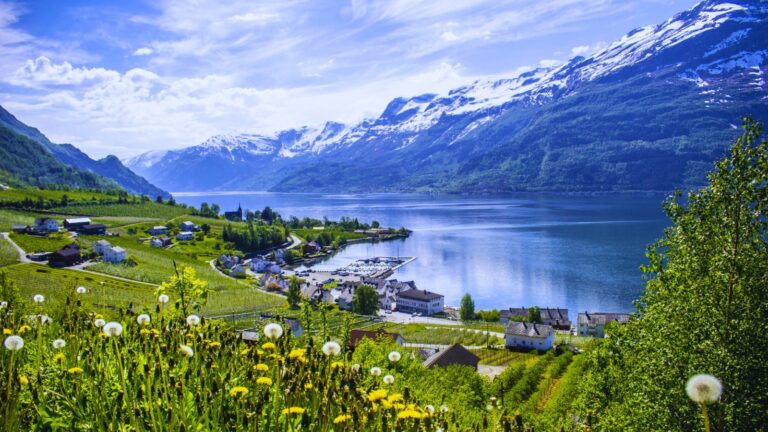
Beyond its fruitful landscapes, Hardangerfjord offers a blend of outdoor activities, from hiking iconic trails to the Trolltunga rock formation to exploring the serene Folgefonna glacier.
Visitors can immerse themselves in traditional Norwegian culture through local crafts and cuisine, making Hardangerfjord an ideal destination for those seeking both adventure and a genuine taste of Norwegian life.
How best to visit one of Norway's best fjords? I've visited the region on both a road trip and a cruise ship, so I've seen different perspectives on this wonderful place. Let's dive in!
Introducing the Hardangerfjord
Stretching 179 km from the Atlantic coast near Bergen to the heart of Norway, Hardangerfjord is a remarkable waterway, even if it doesn’t match the Sognefjord in length or depth.
This fjord cuts through Western Norway’s rugged landscape, lined with scenic towns and villages like Norheimsund, Eidfjord, and Odda, each offering a unique window into fjord life.
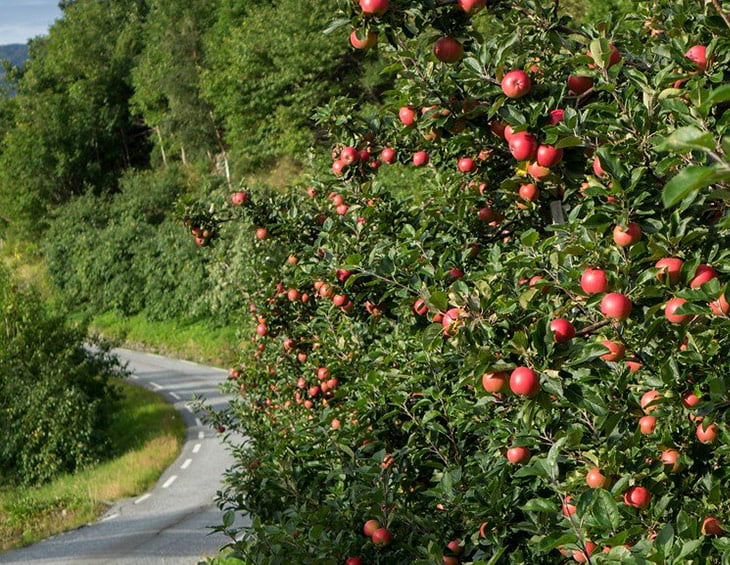
To experience Hardangerfjord’s dramatic beauty, journey inland where the fjord narrows, winding past the majestic Folgefonna glacier and its national park, and nearing the Hardangervidda plateau—a vast mountainous region that crowns this iconic stretch of Norwegian landscape.
Plan a Hardangerfjord Road Trip
Often serving as a scenic detour for travellers between Oslo and Bergen, this fjord offers a rich blend of natural beauty and cultural experiences along its 179 km stretch inland from the Atlantic coast.
As such, the Hardangerfjord is an exceptional destination for a road trip through Norway's breathtaking fjord region.
Begin your adventure in the coastal town of Norheimsund, where you can marvel at the picturesque Steinsdalsfossen waterfall—unique for its path that allows you to walk behind the cascading water without getting wet.
Nearby, the Hardanger Maritime Museum provides insight into the region's seafaring heritage, showcasing traditional boat-building techniques.
As you drive along the fjord, you'll pass through charming villages like Øystese, home to the Kabuso Art Centre, which hosts contemporary art exhibitions and concerts.
The route is especially enchanting during spring when the hillsides burst into colour with blooming apple, pear, and cherry orchards. Local farmers often sell fresh berries, fruits, and homemade preserves from roadside stalls and in small town centers, offering a delightful taste of the region's produce.
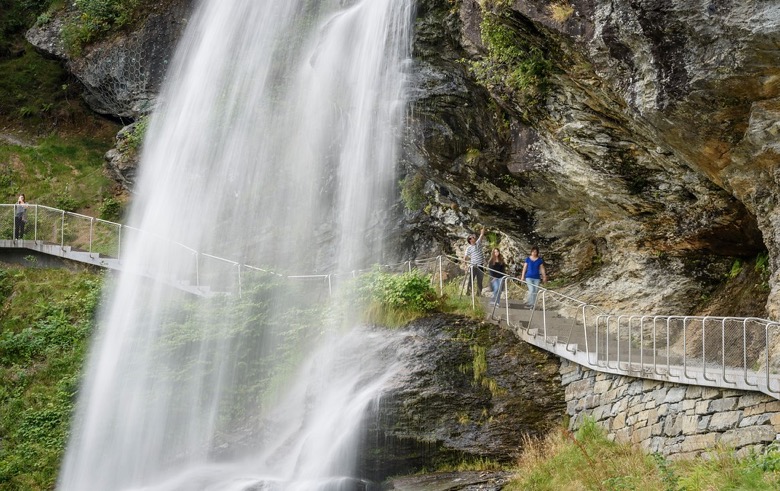
Further inland, the fjord narrows and the landscape becomes even more dramatic. The town of Kinsarvik serves as the gateway to the Husedalen Valley, where hiking trails lead you past four stunning waterfalls in a single valley—an ideal excursion for nature enthusiasts.
Continuing to Odda, situated at the southern tip of Sørfjord (a branch of Hardangerfjord), you'll find access to the famous Trolltunga hike and the Folgefonna National Park, home to one of Norway's largest glaciers.
The Hardangerfjord area is part of one of Norway's 18 National Scenic Routes, with a 158 km drive split into four sections that skirt both Hardangerfjord and Sørfjord.
This route offers panoramic views of towering mountains, deep blue waters, and lush valleys. If you're planning a fjord Norway road trip, incorporating as much of this scenic route as possible is highly recommended.
For a completely different driving experience, consider the mountainous Hardangervidda route, beginning approximately 69 km southeast of Odda.
This route crosses the Hardangervidda plateau, the largest mountain plateau in Europe, offering starkly beautiful landscapes and the chance to encounter wild reindeer herds.
Whether you're seeking outdoor adventures, cultural insights, or simply the joy of driving through some of Norway's most stunning landscapes, a road trip around Hardangerfjord provides a rich and memorable experience that captures the essence of Norwegian natural beauty.
Hardangerfjord Bridge
I've now driven over and sailed under the impressive Hardanger Bridge, spanning the Hardangerfjord. It stands as a remarkable feat of engineering that has improved regional connectivity in Norway's fjord landscape.
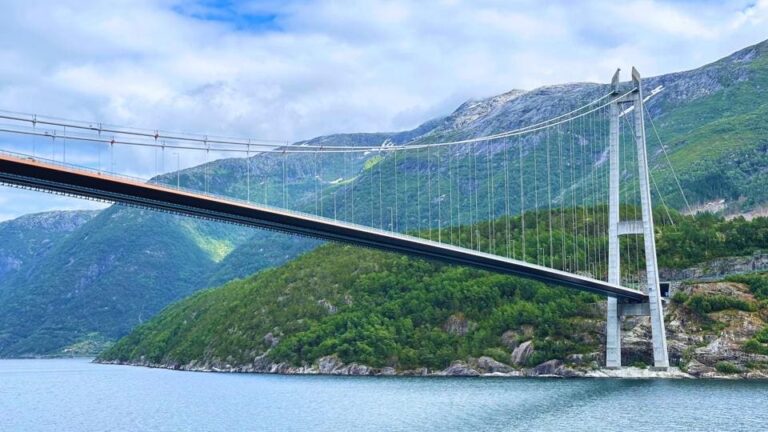
Its elegant design integrates seamlessly into the surrounding natural beauty, featuring tunnels at both ends to minimise environmental disruption.
Completed in 2013, the bridge’s main span, at 1,310 meters, surpasses the length of the Golden Gate Bridge’s main span, making it one of the world’s longest suspension spans.
Designed for both vehicles and pedestrians, the bridge includes lanes for cyclists and walkers to enjoy panoramic fjord views. It has notably improved travel times between Oslo and Bergen, offering greater convenience for commuters and tourists alike.
Despite the toll, the Hardanger Bridge has become an iconic landmark, balancing Norway’s rugged nature with cutting-edge infrastructure.
Eidfjord
Nestled at the innermost point of Hardangerfjord, Eidfjord is a charming community where mountains and fjord waters converge, creating a serene yet dramatic landscape.
It’s an ideal stop for a leisurely lunch or even an overnight stay if you’re exploring Hardangerfjord over several days.
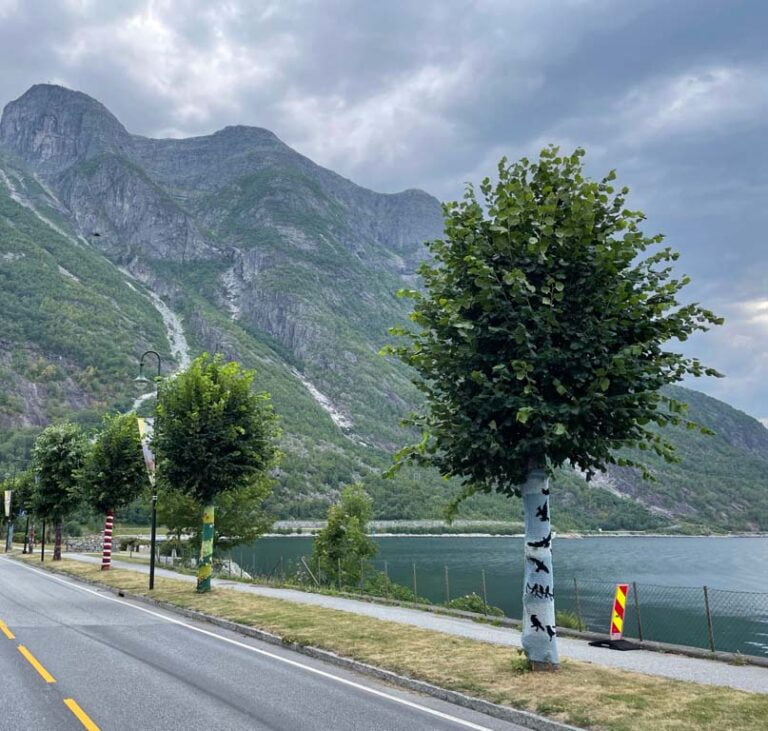
Just a short drive uphill from the village, the Hardangervidda Nature Centre provides fascinating insights into the environment and wildlife of the vast Hardangervidda National Park that stretches to the southeast.
Don’t miss the center’s 20-minute panoramic film, Fjords, Mountains and Waterfalls, which vividly captures the essence of Norway’s wild landscape. The breathtaking scenery might even inspire a longer stay.
Eidfjord is rich in history, with evidence of human activity dating back over 1,000 years. The remains of Viking burial mounds can be found nearby, a reminder of the area’s deep-rooted cultural heritage. For a glimpse of medieval stone architecture, visit the Old Eidfjord Church, built in 1309.
Norheimsund
Norheimsund is a charming village on the shores of Hardangerfjord, often a first stop for travellers exploring the region from Bergen.
Known for its stunning natural beauty and traditional maritime heritage, Norheimsund is home to the Hardanger Maritime Museum, where visitors can learn about Norway’s boat-building history and try hands-on activities.
Just outside the village is Steinsdalsfossen, one of Hardangerfjord’s most popular waterfalls, where visitors can walk behind the cascade.
Ulvik
Ulvik, a peaceful village tucked into one of Hardangerfjord's most picturesque branches, offers an idyllic welcome with its dramatic fjord scenery.
Sailing into Ulvik, you’re greeted by steep, forested mountains descending into calm, reflective waters—a view that seems almost unreal in its beauty.

Known for its fruit farms, Ulvik bursts with colourful apple, pear, and cherry orchards in spring and summer, adding charm to the landscape.
The village is a hub for Hardanger’s cider production, where local cider farms invite visitors to sample traditional Norwegian fruit ciders. Ulvik’s gentle pace and stunning setting make it a true hidden gem on smaller cruise ship itineraries.
Waterfalls in the Hardangerfjord Region
The Hardangerfjord region is renowned for its awe-inspiring waterfalls, drawing visitors with both their beauty and accessibility.
Among these, Vøringsfossen near Eidfjord is one of Norway's most celebrated. Plunging 182 meters from the Hardangervidda plateau into the Måbødalen valley, Vøringsfossen has captivated travelers since the late 1800s.
While it appears remote, it’s actually just a short walk from roadside parking areas, with viewing platforms connected by a dramatic bridge spanning the canyon. Open from mid-May to mid-October due to seasonal snowfall, this trail offers an unforgettable view of Norway’s wild beauty.
Another popular site is Steinsdalsfossen, where visitors can walk behind the cascading water without getting wet—weather permitting!
Though not exceptionally tall, Steinsdalsfossen’s unique vantage point makes it a hit with tourists. It even enjoyed a touch of royal intrigue, as German Emperor Wilhelm II was said to visit almost every summer between 1889 and 1914, helping to popularize the site.
Another intriguing waterfall in the area is Furebergsfossen, cascading directly into Maurangerfjord near the village of Sundal.

I got to see this on a Fred Olsen Cruise Lines ‘fjords and waterfalls' itinerary. The advantage of cruising on a relatively small ship is that the vessels can get up close to some of these magnificent waterfalls.
Easily accessible from the roadside, this powerful waterfall is especially dramatic during spring and early summer when snowmelt swells its flow.
Visitors can enjoy up-close views of Furebergsfossen, where the mist and sound create a truly immersive natural experience.
Folgefonna National Park
Made up of three separate glacial plateaus, the Folgefonna National Park is a remarkable wilderness within easy reach of one of Norway's most famous fjords.
The largest glacial fingers Blomstølskardbreen, Bondhusbreen, and Buarbreen, provide several entry points to the park.
Although appearing solid and safe, glaciers are dangerous places. Only attempt an adventure here with a qualified guide and full safety equipment.
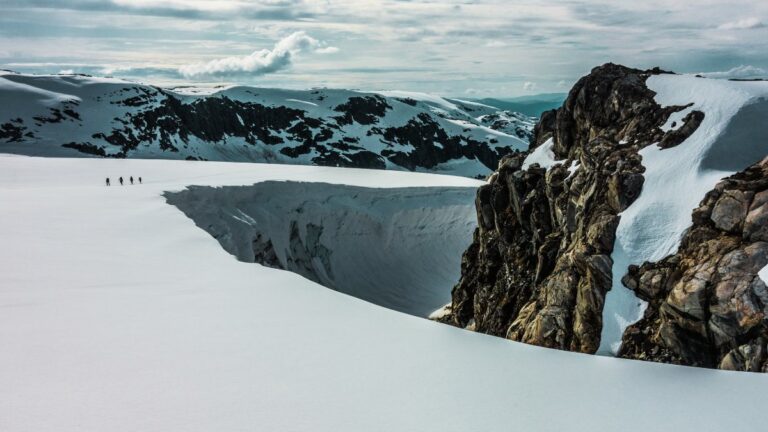
Other than a 19th-century timber framed church (only open during high season) that has an appearance of one many centuries older, Jondal is an otherwise unremarkable village but the best place to stay near the park.
To enjoy some hiking away from the glacier, grab a map from the local tourist office and explore the surrounding area. The Vassenden-Vatnasete hike including Vatnasetevatn lake is a popular tour, with the four-hour roundtrip possible from May to October.
Not many of the world’s ski resorts are only open during the summer, so people of all nationalities take advantage of the unusual summer-only ski season at Fonna Glacier Ski Resort, 19km southeast of Jondal.
Sørfjord
A dagger-like spur of the Hardangerfjord cutting 38km southwards into lush countryside, the Sørfjord (often referred to as Sørfjorden i Hardanger to distinguish it from others) is one of the few narrow fjords you can actually drive along. The roads along either side are narrow but both passing and parking spots are frequent.
Follow in the footsteps of Norway's Queen Sonja by taking her favourite hike. The 8-hour hike high in the mountains between Kinsarvik and Lofthus offers terrific panoramic fjord views of where the Sørfjord and Hardangerfjord meet.
Due to the high altitude, the hiking trail is only open from July through to mid-September. It it's too much for you, a shorter version of the hike starts in Røte.
Odda and Trolltunga
At the end of the Sørfjord is the small town of Odda, the main commercial centre serving the inner Hardangerfjord region.
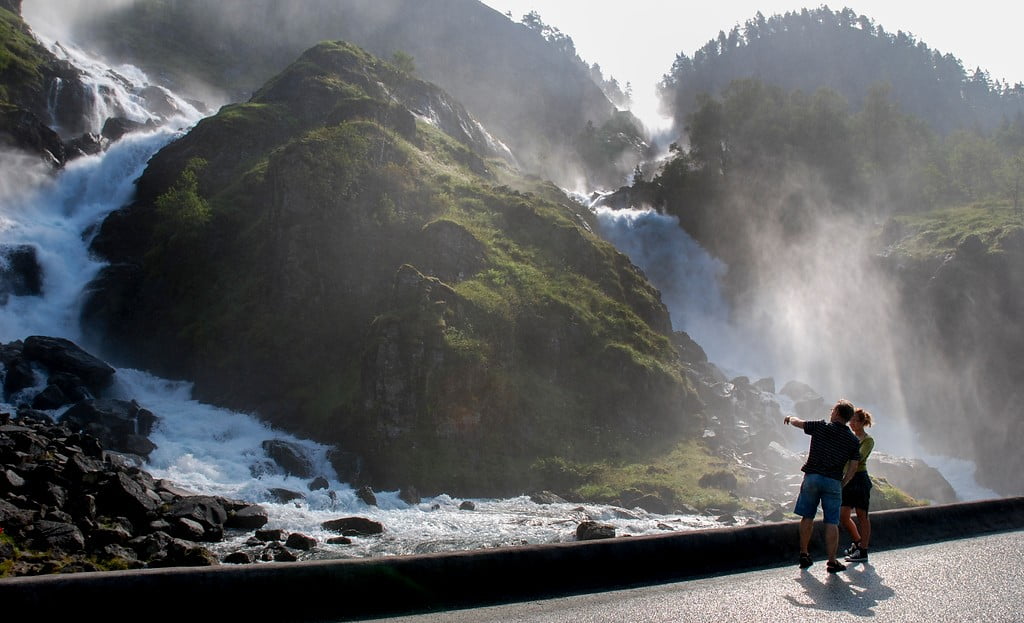
While there isn't much of interest in the town itself, it does provide several accommodation and dining options to break up an active vacation or road trip.
The town is also the main overnight spot for travellers who wish to make the famous all-day hike to Trolltunga. So much so, that the town's tourism website features Trolltunga front and centre.
The Odda region is also home to Låtefossen, a striking twin waterfall near Odda. With two parallel streams tumbling down a steep cliffside, Låtefossen is easily viewed from the road, creating a dramatic drive-by experience for those exploring the region.
Be prepared to get wet! The water smacks into the rocks, creating an immense roar and sprays of mist. All of a sudden, you're soaking wet! Kids will love the fairytale-like aesthetic. Just be sure to keep a close eye on them!
Have you been to the Hardangerfjord? What did you think of it? I'd love to hear your thoughts and experiences down in the comments.
Also, if you're planning a trip to the region, why not share your plans on Pinterest? We've got just the pin for that. Just hit those social sharing buttons to get started.


I’m surprised there’s no mention of Ulvik in this, which is known for the cider farms and is called the pearl of the Hardanger. Ulvik was home to the famous poet, Olav H. Hauge, and the writer/artist/hiker, Catharine H. Kølle (many of her things are housed in the University Museum of Bergen). In addition to the cider farms (and, of course, Brakenes Hotel), there are many hikes in Ulvik, an old church with hand-painted walls and altarpieces, the Olav H. Hauge Center, a swimming area, an old schoolhouse that was left standing during the war because it was believed to be a church, the old mill (dismantled from Bergen, shipped and put back together in working order), and a great tourist office with locally-made wares. There’s also Osa with the gallery, hiking, and Cafe, as well as Finse (aka Hoth for nerdy people) with a great glacier and even more hikes.
I’d also like to point out that Odda is more than just a starting point for Trolltunga.
I absolutely agree with you that is much more to odda than being the staring point of trolltunga. The town has a an interesting history of being a hot spot for tourists in the late 1800 hundreds and early 1900. For example emperor Wilhelm 2 of Germany often stayed in odda for seeing the nature. He has his own rock by Låtefoss. Odda was also a very important industrial town. The neighbouring town Tyssedal have a industry museum where they show how the electricity was made by water power and how the two towns where created in the wake of this. You have a big lot where a factory was in the middle of odda where you can walk around. And also it’s lots of hikes around the area which is not trolltunga. You have the glacier and the fjord. I absolutely agree with you that is much more to odda than being the staring point of trolltunga. The town has a an interesting history of being a hot spot for tourists in the late 1800 hundreds and early 1900. For example emperor Wilhelm 2 of Germany often stayed in odda for seeing the nature. He has his own rock by Låtefoss. Odda was also a very important industrial town. The neighbouring town Tyssedal have a industry museum where they show how the electricity was made by water power and how the two towns where created in the wake of this. You have a big lot where a factory was in the middle of odda where you can walk around. And also it’s lots of hikes around the area which is not trolltunga. You have the glacier and the fjord.